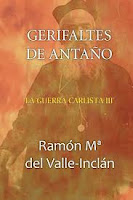
Original language: castellano
Year of publication: 1908-1909
Valuation: Recommended
Within the literary career of Don Ramón del Valle-Inclán, the series dedicated to the Carlist War is a kind of continuation of the modernist stage of the Sonatasalthough revealing elements that point in other directions. We can also detect data that places us on Valle’s ideological itinerary, but let’s get to the point, there is a lot to tell.

Although over time he evolved towards republican positions and finally close to anarchism, the Galician author was initially very close to Carlism, not so much because of dynastic convictions as because of his repudiation of liberalism and a certain identification with the traditions and rural soul of his land. native. This is seen very well in The crusaders of the causethe first of the three novels of the Carlist cycle and, in my opinion, the most brilliant. Handling characters that before and after would have a leading role in other works (the marqués of Bradomín, Montenegro y Silver Face, for example), the narrative focuses on that dark Galicia with primitive rather than traditional features, populated by nobles with a glorious past who have fallen into disrepair, young people inflamed by conservative convictions that they share with illiterate villagers, and sinister nuns willing to take action in defense. of their values.
The painting is presented immersed in a murky atmosphere of violence and conspiracy, a mysterious fog under which forces as heterogeneous as they coincide seem to gather in the advance towards an objective that, above the political, seems spiritual. The atmosphere, tense and suffocating, sometimes recalls the fascinating darkness of divine wordsanticipating immersion in that barbaric world.

The glow of the bonfirewhose prose recovers modernist elements with more vigor, transfers the setting and some of its characters to Navarra, one of the main centers of Carlist resistance. At this point, Valle shows a broader list of combatants, without failing to show his roots in the rural world where war skirmishes take place. In my opinion, there are too many characters, and somewhat confusing episodes that spoil the whole to some extent because I think that narrative is not Valle’s forte, I would even say that it is not what interests him the most. He enjoys drawing human types, making them evolve and interact, and thus the story of the war clearly remains in the background. The descriptions and, above all, the dialogues, are always the most important thing, to the point that it seems perfectly viable to perform any of these works on stage (I don’t know if it has ever been done).
Even so, this second book leaves us with memorable characterizations, such as that of the hero Miquelo Egoscueand brutal scenes, so Valleinclanesque, like that of Roquitowhose eyes burn while hiding in a fireplace (and sorry for the spoiler). Also here the character of the priest Santa Cruz timidly appears, who will take center stage in the third installment.

Indeed, in this Gyrfalcons of yesteryearthe well-known Carlist guerrilla equally overshadows the rest of the characters and the development of the action itself. Santa Cruz is like a bad guy (or a hero, depending on how you look at it) in a movie. Coming from a small Gipuzkoa parish, his reason for being and living is none other than to fight the liberals, the war has become an end in itself, and his abilities to escape, camouflage or lay ambushes are only comparable to his inflexibility and lack of scruples. The locals identify with the solitary hero although they also fear him, and the ungovernable character of the priest and the spread of terror by his followers end up uniting liberals and official Carlists to fight him.
Valle’s profile has hardly any wrinkles because Santa Cruz either has no cracks, or if at some point he shows doubt it will only serve to reaffirm his position and opt for the most brutal solution. It is certainly not a caricature, but the drawing of a character who seems to feel within himself the crystallization of all traditional values and the determination to make them triumph whatever the price. It can be said that Valle enjoys handling the guerrilla priest, watching him evolve, occupying the entire narrative space, and once again leaves the development of the war in the background. He is more interested in discovering the individual who embodies an ideological and spiritual position taken to the extreme.
So the trilogy (which was planned to be completed with two more titles) may attract less to those looking for a novel itself or a descriptive story of a historical nature, but it will satisfy those of us who admire a master in discovering the soul of the things through their dialogues, their characters and their atmospheres.
Other works by Ramón del Valle-Inclán reviewed in ULAD: Divine words, Tyrant Flags, Bohemian lights, Spring Sonata
Source: https://unlibroaldia.blogspot.com/2025/01/3-x-1-ramon-del-valle-inclan-la-guerra.html


